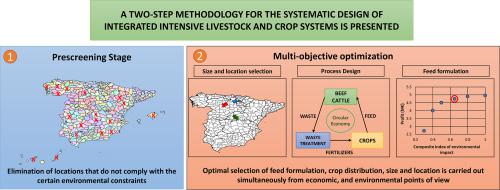Agricultural Systems ( IF 6.1 ) Pub Date : 2022-09-27 , DOI: 10.1016/j.agsy.2022.103517 Manuel Taifouris , Mariano Martín

|
CONTEXT
A mismatch between nutrient demand and consumption in livestock and cropping systems makes these sectors responsible for 24.5% of greenhouse gas emissions. In order to reduce the gap between the two industries, approaches focused on integrating livestock and crop management have been presented. Location is a key factor in the sustainable operation of these integrated systems since this variable affects both the economic and environmental dimensions of the design of the farm.
OBJECTIVE
In this work, a two-step methodology is proposed to address simultaneously the formulation of the feed, the design of the nutrient recovery process, the location of the facilities, and its size, from economic and environmental points of view.
METHODS
First, prescreening is used to discard locations that do not meet a series of environmental constraints. Next, an optimization framework is developed by integrating empirical models that estimate the nutritional needs of the animals, fertilizer consumption, waste production, as well as the effect of selection of locations and the size of the farm on the objective function. The farm is designed to produce the feed on the premises and animal wastes are used to produce fertilizers and biogas, implementing the circular economy. The optimization framework is used to estimate the optimal feed formulation, crop selection, size and location, following a multi-objective approach.
RESULTS AND CONCLUSIONS
The methodology is applied to a case study in Spain. Of the 345 agricultural districts considered, 145 are discarded in the prescreening. The optimal number of initial animals is 1000. The results show that the selection of ‘Bureba-Ebro’ and a crop distribution that consumes 12% less nutrients than the economic scenario, results in the reduction of 35% in the environmental impact. In addition, meat production cost is 8.87€/kg (1.6€/kg corresponds to the waste treatment). Nevertheless, it can be reduced down to 1.51€/kg by considering the income from crop sales.
SIGNIFICANCE
Only through this integrated framework it is possible to determine the feed formulation and facility location that best balance the economic and environmental objective, and determines the percentage of nutrients that can be recovered. The methodology is generic enough to be applied to other locations, crops, and animals.
中文翻译:

整合集约化畜牧和种植系统:可持续设计和选址
语境
牲畜和种植系统中养分需求与消耗之间的不匹配使这些部门产生了 24.5% 的温室气体排放。为了缩小这两个行业之间的差距,提出了侧重于整合牲畜和作物管理的方法。位置是这些集成系统可持续运行的关键因素,因为该变量会影响农场设计的经济和环境方面。
客观的
在这项工作中,提出了一种两步法,从经济和环境的角度同时解决饲料的配方、养分回收过程的设计、设施的位置及其规模。
方法
首先,预筛选用于丢弃不符合一系列环境约束的位置。接下来,通过整合经验模型来开发优化框架,这些模型估计动物的营养需求、肥料消耗、废物产生,以及位置选择和农场规模对目标函数的影响。该农场旨在生产场所内的饲料,动物粪便用于生产肥料和沼气,实施循环经济。优化框架用于按照多目标方法估计最佳饲料配方、作物选择、大小和位置。
结果和结论
该方法应用于西班牙的一个案例研究。在考虑的 345 个农业区中,有 145 个在预筛选中被丢弃。初始动物的最佳数量为 1000 头。结果表明,选择“Bureba-Ebro”和消耗比经济情景少 12% 的养分的作物分布导致环境影响减少 35%。此外,肉类生产成本为 8.87 欧元/公斤(1.6 欧元/公斤对应废物处理)。尽管如此,考虑到作物销售收入,它可以降低到 1.51 欧元/公斤。
意义
只有通过这个综合框架,才有可能确定最能平衡经济和环境目标的饲料配方和设施位置,并确定可以回收的养分百分比。该方法足够通用,可以应用于其他地点、作物和动物。











































 京公网安备 11010802027423号
京公网安备 11010802027423号